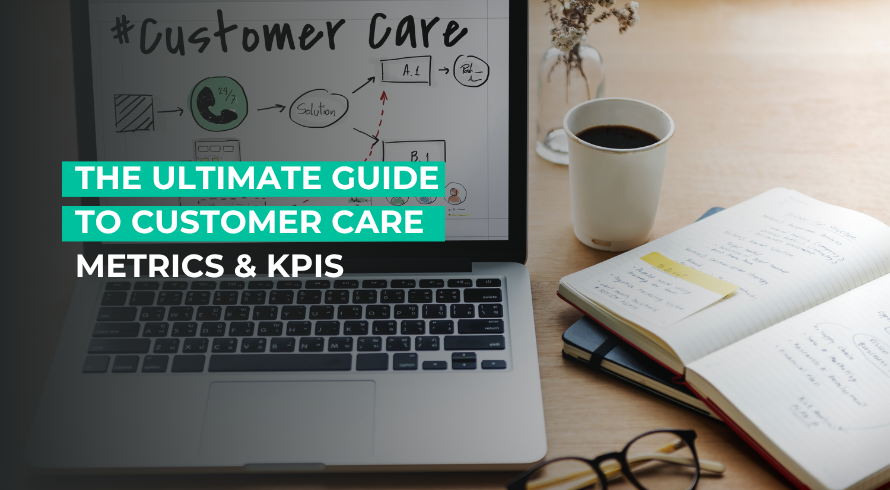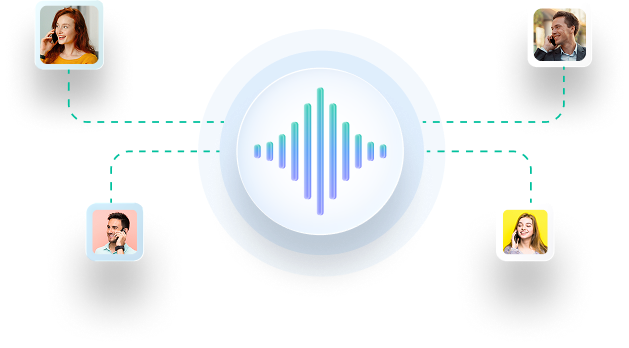Customer care metrics tell you how happy your customers are. It’s important to measure these metrics correctly. That’s when you can know whether your customers are satisfied or not.
Why is it important to do so? That’s because a happy customer keeps coming back. They will keep buying your products or services, increasing repeat sales. And they will have fewer or no complaints, meaning lower support costs for fixing queries.
Understanding customer care metrics
Metrics vs KPIs
Let’s start with the basics. Every business has some goals to meet; for example, the business wants to know customer loyalty. Here, customer loyalty is a key performance indicator (KPI). This is the goal that the business works towards, trying to achieve 100% loyal customers.
But how do they do it? They would set metrics. It is similar to dividing the overall objective into activities. Each department has a metric to track.
Let’s say the marketing department chooses net promoter score (NPS) as a metric to calculate customer loyalty. They share a single-question survey for customers to fill out. The customers have to rate on a scale of zero to ten.
The survey answers are totaled, and the final score is used to calculate the NPS score.
A 9 or 10 score is a promoter, an 8 or 9 score is passive, and below that are detractors. All the scores are collected by the department and then separated into the following segments.
Let’s assume the scores are as follows:
- 75 promoters
- 15 passives
- 10 detractors
The net promoter score will be promoters minus detractors; that is, 75-10=65. This is a good NPS score, meaning 65% of customers are loyal. But also shows that the business has room for improvement and can reach 100%.
Lagging vs leading indicators
Leading and lagging indicators are both metrics used to track performance.
Leading indicators help predict and plan for future outcomes. On the other hand, lagging indicators are used to measure past performance so businesses can review their success.
As discussed above, the survey and NPS score are called lagging indicators. The survey shows how the business has been performing since the beginning till today. And the NPS score is what they achieved as an output.
How can a business achieve 100% customer loyalty? The KPIs are still the same, but they now need leading indicators. They will review these metrics and performance scores and dig deep into why the other 35% are not loyal.
17 Important customer care metrics to track
Some of the essential customer care metrics to add to your business KPIs:
1. First response time
This is the time it takes for a business to respond to a customer inquiry or complaint. The support team needs to calmly respond to such queries and also explain the time it will take for the team to fix.
2. Average handle time
It is the time from when a customer calls to when that call ends. This is to see how well and long the support team talks, how long the call is on hold, and how many calls they can handle in a day.
3. Average resolution time
This counts how long the teams took to resolve a customer query. The time is usually different because of issue complications, the number of staff available, or the load of complaints.
4. First contact resolution
The percentage of issues solved in the first call with the customer.
5. Customer satisfaction
A score that tells how happy your customers are with your products or services.
6. Quality assurance score
An internal check on how teams interact with customers. These interactions are examined based on rules that are to be followed.
7. Ticket volume
This is the number of customer issues or complaints.
8. Ticket backlog
The outstanding issues that were not resolved by the end of the period.
9. Contact rate
The number of requested support customers. It shows how much customer service is needed. But the reasons for support tell you whether it was general support or a complaint call.
10. Agent Occupancy
How much time an agent spends on customer care work. The total time starts from the customer call, analyzing the issue, and resolving the issue to informing the customer of the solution.
11. Schedule Adherence
The number of hours an agent works out of the scheduled hours. Assume their allocation is 150 minutes, and they took an extra half an hour off, so they only worked 130. The scheduled adherence will be 130/150=86%
12. Agent productivity
How well the agent talks to the customers and gets their issues fixed. The productivity is calculated on the quality of the call and the satisfaction of customers after the call.
13. Self-service rate:
Customers who find the solution on their own. They would search for how-to guides or tooltips to follow before going for a ticket. They also use AI chatbots, a quick way to ask about basic flows such as resetting passwords.
14. Knowledge base usage
How many customers are viewing your business’s FAQs and support blogs? After reading through, they might have some questions, and they contact support for clarification.
15. Cost per contact
How much does it cost to interact with a customer? Usually calculated as total cost divided by the number of customer calls.
16. Customer retention/churn rate
The number of customers retained or lost during a period.
17. Net promoter score (NPS)
This determines a customer’s loyalty to your brand.
Industry benchmark and examples
The outcome of customer service metrics is important for businesses. They use the results to keep a record of how well they are performing. They use benchmarks that are set as a bar to know which metrics are performing good or bad.
Benchmarks can vary because of industry, competitors, or the size of the business.
Some of the average CSAT scores in different industries in 2025 are as follows:
- B2B Software & SaaS: 77
- Hotels: 75
- Banks: 78
So, does a software achieving above 77 mean customers are very satisfied? It might, yes, but it also depends on the number of surveys taken. Any business scoring a 100 customer satisfaction score on a very low number of surveys doesn’t always reflect a good picture. This is why businesses should have their own internal baseline. Following that, they should see which metrics need improvement and which are doing well.
At times, different services in the same business require different baselines.
For example, an auto shop business uses the average handle time metric. This reveals that questions on tire servicing take 3 minutes longer than other services. Auto shop owners would have to compare such calls to a different baseline for accurate performance.
Time of the day matters for some businesses. Assume that an e-commerce store monitors first response time. They discover that they need more staff during daytime shifts when there are more calls.
Industry applications of customer care metrics
Tracking customer service metrics is crucial for any business, regardless of what industry it is. In fact, they all use these metrics to improve overall service quality, reduce churn risk, and boost customer satisfaction. But it’s important to keep in mind that while key metrics like response time, CSAT, and resolution time stay the same, their use cases differ based on business operations.
Here are a few industry use cases:
1. B2B SaaS and software companies
B2B companies pay more attention to metrics like ticket volume, average response time, self-service rate, and churn rate as they reflect how users are interacting with the tool and if they’re encountering any issues. Customer satisfaction is crucial to delivering successful customer support in SaaS businesses, so ensuring these metrics are measured and evaluated in the right way is key.
For instance, a lower average response time indicates that the support team is quick in responding to and resolving incoming customer calls. This ensures customers are receiving top-notch customer service and are more likely to be satisfied with the attention they’re getting. On the other hand, a higher response rate shows that the team is unable to handle the volume of incoming calls or that there are issues in task prioritization.
2. Automotive
For service-based industries like tire and auto repair shops, first response time, average handle time, and customer satisfaction are the pillars of getting repeat business. Customers expect quick service delivery and seek personalized experiences at shops so they feel valued.
Sending appointment reminders via email or text, requesting feedback after their visit, or customized follow-ups, these directly impact how customers perceive your business. There was a time when shops did these tasks manually, but with AI technology on the rise, there are many tools to help streamline these workflows in a single platform.
One such tool is AutoLeap AIR, an AI receptionist for auto shops. It takes over customer care and answers all inbound calls, captures customer details, and schedules appointments on the spot. This means shops can take calls even after business hours, on the weekends, and on holidays 24/7. It directly impacts the shops first response time and drastically reduces the load of administrative work on the front desk. When customer inquiries are immediately resolved or raised to the higher-ups, customer satisfaction scores improve as well.
3. E-commerce and retail
In online shopping and retail, metrics like first response time and average resolution time directly affect repeat purchases. Fast resolution of order issues, returns, and delivery complaints builds trust and drives loyalty.
4. Hospitality and travel
Customer service metrics in travel and hospitality may often get ignored when business owners are more focused on delivering clean rooms and flight arrangements. But today’s customers need quick resolution times and seamless customer service in every aspect of their lives.
Metrics such as customer satisfaction (CSAT) and net promoter scores (NPS) help hotels and restaurants track guest satisfaction, room cleanliness, staff behaviour, and other amenities. Collecting this feedback helps identify areas that are excelling and those that need immediate improvement to ensure customer expectations are met.
Omnichannel feedback collection tools like AskNicely and Qualtrics are ideal for hospitality brands that need standardized feedback benchmarking across multiple platforms.
Use dashboards for metric performance
There are different types of customer data metrics that a department has to track. It is quite difficult to figure out from spreadsheets. Plus, the formula and manual entry errors can lead to misleading information and incorrect decision-making.
Dashboard visibility is the solution. The dashboard represents data in the form of graphs, reports, and tables. This makes it easier to look at these metrics and take out any information quickly. Filters can also be applied for specific time periods or customers.
Customer care metrics are divided among the hierarchy. Some metrics are analyzed by managers, some by team members, and some are specific to agents. They can create different dashboards as required.
- The executive dashboard could present a monthly KPI of NPS, CSAT, or churn rate.
- Weekly metrics that can be displayed on the team-level dashboard include the first contact rate, backlog, and quality scores.
- Daily reports can be displayed on the agent-specific dashboards of tickets that are pending, resolved, or adherence scheduled.
Best practice to meet customer service KPIs
Identify the scope of incoming tasks
Finding out the number of tickers is helpful. However, more important is to know the type of tickets you are about to receive. It can be associated with in-app usage, missed orders, or aggravated clients. Being aware of the cause can enable the teams to do what is right and make the customers happy.
Turn repetitive queries into a self-service section
The metrics analysis shows there are more tickets on how to use the website or how to order. Businesses can make a list of all such questions and add them to the FAQ section. This will improve the first contact rate, as agents can share articles or FAQs that resolve customer queries.
Track contact rate
Keep a record of the contact rate. Knowing how many tickets are received and at what time of day. Ensure staffing is adequate to answer customer calls and no calls are missed during peak time.
Assign QA scores for staff coaching
Quality assurance scores are to be used as constructive feedback. No agent should be demotivated due to their low QA score. The manager should provide feedback on how to improve their metrics and guide them wherever they face difficulties.
Implement tech to improve processes
Use technology and improve performance metrics for customer service. For example, service-based industries like auto repair centers are quickly adopting technology in their processes to streamline operations.
Do’s and don’ts of analyzing KPIs
Managers or top tiers often lose direction when analyzing customer care metrics. The following are some of the areas of focus and errors that should be avoided:
Areas of focus | Areas to avoid |
Keep a check on ticket volumes and try to set a baseline for improvements. | Do not worry about the number of tickets too much. As long as it’s within baseline, it’s good to have customers concerned and ask for help. |
Segment data and take averages by segment. | Do not take the average of all. This might hide the problem. A new hire takes more time on their first calls than experienced agents. |
Different channels need different metrics, and these need to be calculated and discussed separately in order to be better and higher. | Do not mix phone calls and chat analysis. Take into account that they both will have different AHT or FHT metric outcomes. |
Analyze issue types separately. | Do not mingle generic and complex issues. A simple working hour question takes less than a minute to answer compared to explaining how to order online. |
How to implement customer care metrics?
The first step you can take before implementing your metrics is to ensure that you have a shared and consistent definition of what each metric really entails. After that is resolved, determine where exactly you will get the data required to do so, be it your phone system, CRM, or helpdesk platform.
After securing reliable data sources, start creating dashboards that will cater to the various levels of the organization, starting with the executives and down to managers and frontline agents. Then, maintain achievable objectives by establishing the baseline performance and setting realistic targets of improvement.
Lastly, keep track by conducting performance reviews or weekly or monthly meetings. It’s important to analyze historical data, discuss challenges, and strategize to improve and perform better.
Conclusion
Businesses have their utmost priority in providing a great customer experience. A smooth, end-to-end experience results in happy customers turning loyal to the brand. This is why it’s important to set customer care metrics, decide on a baseline, analyze progress, and improve periodically. All of this is to meet customer demands and keep them happy.
FAQs
How do you measure customer service performance?
Businesses set different KPIs and metrics to measure customer service performance. Some of the important ones are net promoter score and customer satisfaction score.
What is a good CSAT score?
A good CSAT score is any number near 100. However, every industry has a different benchmark for CSAT score, depending on their business size, type, and competitors in the market.
What is the difference between a metric and a KPI?
KPIs are the main target or goal of the business. These KPIs are broken down into metrics for teams to work towards, achieve, and improve metric performance.








